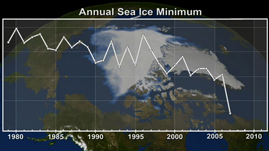Teachers' Domain - Digital Media for the Classroom and Professional Development
User: Preview




Geographic knowledge is critical when faced with a challenge based on changes in the natural environment. For example, the rise in sea levels that scientists attribute to global warming can be tracked with sensors on satellites. Scientists can then assess the future risk of floods for a coastal population based on observed trends.
Analyzing the significance of location requires basic knowledge about a place. Location can be both absolute (i.e., longitude and latitude) and relative (i.e., where a place is in relation to other places). Global positioning systems (GPS) like those you use for driving directions find your absolute position by plotting your location at the intersection of imaginary spheres (picture a Venn diagram) generated by signals of several satellites and then placing that location on a stored map. The relative location of oil fields, for example, makes roads or waterways that access the resources more significant.
Places have both physical and cultural characteristics that blend to reflect the unique nature of a place. For example, physical features might include its landforms and water, weather, soil, and native plants and animals. The culture of a place is determined by a variety of factors: the population, settlement patterns, and race and ethnicity of the people, as well as their languages and religions, economy, architecture, material culture, and politics.
The interaction of people with their natural environment is influenced by their cultural values. For example, European settlers who came to North America treated the land differently than the Native Americans who had lived on it for generations. Some Pennsylvanians who have farmed for generations are choosing to keep their land as pasture while people who work for energy companies are seeking permission to drill wells on that same land in search of natural gas.
Movement or spatial interactions can be political, economic or cultural in nature. The migration patterns of certain immigrant groups to and across the United States may be viewed from a local angle or from a wider international perspective. The delivery of goods and services found in the grocery store may be physical or electronic and may originate from any place in the world.
The concept of regions allows geographers to subdivide the world into manageable areas of focus. The reason why a region is distinctive can include cultural, historical or physical factors and can change as current events realign political and economic relationships amongst countries.
To learn more about the history of geography, check out a video resource that traces the origin of maps to clay tablets in Babylonian times Geospatial Revolution: History of Geography.
To learn more about why you might want to study geography, check out a video resource that illustrates how maps can help you protect yourself and your house from an emergency, like raging wildfires Geospatial Revolution: Why Study GIS?.
To learn more about political geography, check out a video resource about maps that revealed potential voters during the 2008 presidential campaign Geospatial Revolution: Political Aspects.
To learn more about the history of GIS, check out a video resource that traces the development of GIS from centuries of mapmaking to 21st century computer-based technology Geospatial Revolution: History of GIS.
To learn more about vocabulary that has developed with the growth of GIS, check out this interactive with relevant videos and embedded assessments of your understanding Geospatial Revolution: GIS Vocabulary.
To consider the expanded roles and responsibilities of citizens and government In the digital age, check out a video resources that profiles a city using technology, especially geospatial applications, in a variety of operations. Geospatial Revolution: Portland, an Interactive City.
To consider how GIS technology is helping address the lack of easy access to fresh food in high poverty neighborhoods, check out a video resource that profiles Philadelphia's use of geospatial applications. Geospatial Revolution: Food Deserts.
To consider how technology is rapidly changing the nature of jobs and careers in ways that will affect your opportunities, check out an interactive resource that profiles several job requirements at UPS. Geospatial Revolution: Your Next Job.
To learn more about how GIS is used to monitor areas of conflict, check out a video resource that shows how the US military uses GIS to protect soldiers in combat Geospatial Revolution: GIS to Monitor Areas of Conflict.
 Loading Standards
Loading Standards